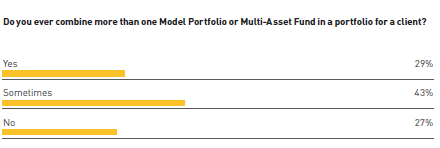
The growing trend of combining multi-asset funds in a single client portfolio
Multi-asset funds offer robust solutions in accumulation, decumulation and income-seeking strategies by providing advisers with a one-stop shop for cost-effective asset allocation, risk management and rebalancing. Based on these merits, they have become popular amongst advisers for use in client portfolios over recent years. Increasingly Advisers are also blending two or more multi-asset funds within one portfolio- a trend that was evident in the results of the FE Adviser Survey 2018.
The FE Adviser Survey 2018, studied views from around 130 advisers to understand the processes that drive their investment selection. The results showed that 73% of those surveyed were blending or combining their clients’ assets in a single portfolio across more than one model portfolio or multi-asset fund- up from 71% in the 2017 survey and 64% in 2016. The survey showed that 29% did so regularly, with 43% doing so sometimes.


The respondents believed that blending two or more multi-asset funds led to increased diversification and improvement in risk management efficiencies. However, FE research shows that this is not necessarily the case.
Why you should reconsider ‘blending’
By nature, multi-asset funds are essentially delicately constructed portfolios that strive to achieve a particular objective or risk budget. Blending multi-asset and other model portfolios appears to be happening because some advisers believe that it automatically increases diversification. It may be that certain clients want to combine multi-asset or model portfolios where they have different buckets of investments with different time horizons and risk requirements. However, where this is not the case, blending in this way will not automatically increase diversification.
The key to efficient portfolio construction is optimising the diversification ratio, which entails understanding how each fund works with every other fund in the portfolio to increase the portfolio’s overall diversification, thus ensuring maximum market exposure for the same level of risk. The impact of different funds can be identified by charting the actual volatility of a portfolio versus the weighted volatility of the constituents of the portfolio. The greater the difference between these two numbers, the greater diversification benefit the portfolio is achieving. As the number of funds increase, a portfolio starts to lose its diversification benefit and becomes less optimal. Blending too many holdings into a portfolio can cause extra layers of cost and introduce correlations that move the investor’s portfolio further away from the efficient frontier of risk and return.
Blending can also lead to massive skews within the client’s overall asset allocations. Advisers should be cautious of this unplanned overexposure by conducting granular research on the funds – a view supported by research from The Lang Cat that says it is impossible for advisers to determine the suitability of multi-asset and MPS models by looking just at aggregate data and emphasise the need to ‘drill down’ into the detail.
How FE can help
FE’s research team research and rate hundreds of multi-asset funds each month. They have also created a dedicated risk-targeted universe of multi-asset funds, based on their risk scores (available on FE Analytics). From this universe, the FE Research team have made a shortlist of preferred funds, selected after careful scrutiny using a diligent quant + qual methodology. The resultant 21 multi-asset funds in the FE Invest Approved List, represent the best of breed in the asset class.
If you use multi-assets, are blending or have inherited a legacy client record, our dynamic portfolio analysis tool (DPT) can provide you with the overall Diversification Benefit of the portfolio alongside giving you a fully detailed breakdown of the portfolio’s asset, sector, regional weightings and holdings – providing you invaluable insight to monitor and correct any overexposures or unintended consequences of combining these funds together and ultimately help you ensure you continue to meet your clients’ investment objectives.
Discover our Managed Portfolio Service.